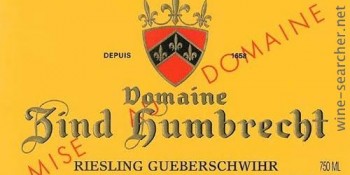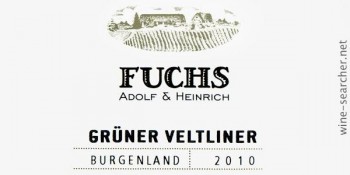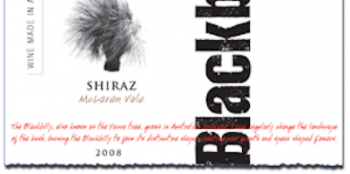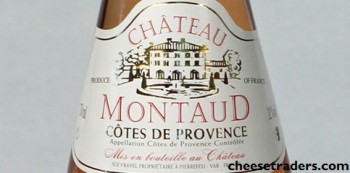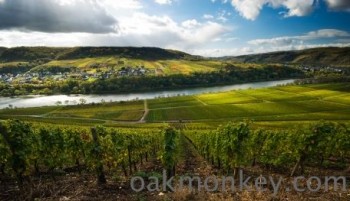The East Coast has, historically, not exactly been known for fine wine. Over the past half century, most of the eastern United States has been identified with grapes grown for Welch’s grape juice or for syrupy, sickeningly sweet wines. Today, the wineries of the Finger Lakes region of New York are demolishing those old expectations with delicious, sophisticated offerings.
Most of the grapes grown on the East Coast in the past have been either native to North America, like Concord and Niagara, or are a hybrid of native and European wine grapes. Wines made from native vines are, for lack of a better word, “grapey”: they taste like grape juice — or, rather, sweetened alcoholic grape juice. The lesser of the hybrids taste that way, too. Both often exhibit what winos call a “foxy” character: a musty, wild smell, like a closet full of fur coats. Not exactly appetizing when thinking about something to drink with dinner.
So why plant these grapes? A big part of the reason is climate. Native and French-American hybrid grapes have a higher tolerance for cold winters and hot, humid summers. Grapevines are particularly susceptible to various fungal infections (or “rots”), and the humid climate of much of the East Coast encourages their growth. Areas south of northern Virginia are mostly out of the question for European wine grapes.
The opposite problem occurs in the Northeast, where winters get too cold for grapevines to survive. (And it is still too muggy in the summer.) Another hurdle has been phylloxera: the tiny, sap-sucking insects native to the soils of eastern North America that feast on certain grapevine roots including — you guessed it — the European varieties. Native grapes are immune, as are some of the French-American hybrids. But in Europe, where phylloxera did not exist before the late 1800s — when the pest arrived via boat and destroyed most of the vineyards, especially in France — many of the vines were susceptible. As European varieties proved to be unsuccessful in America, vintners in the East planted what they knew they could grow.
While native and hybrid grapes have dominated vineyards along the East Coast for years, there has been a very slow-but-steady march toward trying to grow European wine grapes, like the great fruits of Bordeaux and Burgundy, and, later, varieties like Napa and Sonoma that are renowned on the West Coast. Even grapes like Cabernet Franc, Pinot Noir, Riesling, and Chardonnay are being grown now on the East Coast.
The rise of fine Eastern wines has been in step with advances in technology and agricultural techniques. Better planting, vigilant maintenance, improved fungicides, and successful grafting — the process of attaching the European varieties to the roots of a phylloxera-resistant vine — have all contributed to growing wine grapes in less-than-ideal regions.
This effort started in the Finger Lakes region of central New York state, near the picturesque towns of Ithaca and Geneva. (Over time, more wine regions along the East Coast have popped up, like Loudoun County, Virginia, Long Island, the Hudson Valley, and the Niagara Escarpment.) The Finger Lakes — resembling the fingers of a stretched out hand when viewed from above — were created millennia ago by deep glaciers, carving the land as they grew and receded. Keuka, Seneca, and Cayuga Lakes are the largest and best known for winemaking. The stony soils of land sloping down to the lake provide the good drainage that grapevines need. (They don’t like “wet feet.”)
The deep lakes provide a buffer to the changing seasons. In the fall, before the lakes freeze over, the heat trapped in the lake water keeps the nearby vineyards slightly warmer to prevent frost damage before harvest. In the spring, the ice on the lakes keeps the vineyards cold longer, minimizing early growth and the risk of frost damage.
The history of Finger Lakes wine was recently chronicled in Summer in a Glass, a book by Evan Dawson — an insightful and easy read. Russian immigrant Dr. Konstantin Frank was an early pioneer in planting European varieties on Keuka Lake, as far back as 1958. He released his first vintage, a Riesling, in 1962. Hermann J. Wiemer, an immigrant from Germany, was also an important early grower of fine Finger Lakes wine on Seneca Lake. Both wineries are still in operation today, and are among the most successful in the region.
White wines are the real stars in the Finger Lakes. That’s not to say the reds are bad (although some certainly are). Chardonnay is produced by many wineries in abundance, and with quality techniques, but the Rieslings in particular shine bright. Most are dry, clean, racy wines that zing with acidity and evoke a strong flavor profile of citrus and minerality. Rieslings are to the Finger Lakes what Cabernet is to California — the signature wine of the region, the grape best suited to the climate and soil. Those at Hermann J. Wiemer are some of the best — not just in the Finger Lakes, but in the entire United States. Ravines Wine Cellars, down the road from Dr. Konstantin Frank, on Keuka Lake, also produces shockingly good Riesling. Their Dry Riesling was recently named to Wine Spectator’s prestigious Most Exciting Wines list.
Domaine LeSeurre, a brand new winery on Keuka Lake, has created world-class Riesling in their first Finger Lakes vintage. Céline & Sébastien LeSeurre chose the Finger Lakes as their home after working 15 different vintages around the world. Sébastien, from a six-generation winemaking family in Champagne, makes wine that will not disappoint.
If you have dough to spare, try some of the single-vineyard Rieslings. Most of the Riesling in the Finger Lakes come from various vineyards, all brought together to be crushed, juiced, fermented, and bottled. But a few wineries produce Rieslings sourced from a single vineyard, which, tasted next to each other, can produce remarkably different flavors. This is a prized feature among winos, what the French call “terroir“: a sense of place evoked in the wine. For example, a Riesling from one vineyard, where the soil is more gravelly, contains more limestone, and drains more quickly, will have different aromas and flavors than a vineyard whose soil contains more clay. Red Newt Cellars produces four outstanding single-vineyard Rieslings, two dry and two sweet.
Pinot Noir and Cabernet Franc are the best reds. While the big Cabernet Sauvignon wines of California and Shirazes from Australia burst with flavor and tannins, the reds of the Finger Lakes are decidedly more Old World in style: lighter in body and color, with more delicate and nuanced flavors. Heart and Hands Wine Company, on the eastern side of Cayuga Lake, has created world-class Pinot Noir.
Sparkling wine has also taken root in the Finger Lakes, with many wineries now producing dry, Champagne-style bubblers. Red Tail Ridge, on Seneca Lake, has created a Blanc de Noirs and a Sparkling Rosé, both fantastic. Red Tail Ridge has a thirst for experimentation, growing some unfamiliar grape varieties, like Blaufränkisch and Dornfelder from Germany, and Teroldego from Eastern Europe, all while operating in environmentally responsible ways. Oh, and their Pinot Noir, Riesling, and Chardonnays are really good, too.
A four-hour drive from Philadelphia, New York City, and Toronto makes the Finger Lakes a perfect weekend getaway for millions. If you decide to visit, there are plenty of hotels in Ithaca, Watkins Glen, and Geneva, though the region is also full of quaint bed-and-breakfasts. If possible, try to avoid a big race weekend at Watkins Glen speedway. (The traffic is not fun.)
Restaurants are also plentiful, and a few have become nationally recognized, like Suzanne Fine Regional Cuisine, nominated for a James Beard award and recognized annually by Wine Spectator, or the Bistro at Red Newt. For those without the wine craving, there are plenty of outdoor activities, like boating on the lakes or hiking along the waterfalls and canyons of Watkins Glen State Park.
Depending on how serious you are about tasting and how close together the wineries you choose, you’ll probably visit between six and 10 wineries each day. Six is more than enough for some, while others will wish the wineries were open past 5 p.m. so they could visit 11 or 12. Each winery offers wine tastings; a few are free, but most cost from $2 to $5.
Be prepared with water and snacks in the car: you’ll likely drink the equivalent of at least one regular-sized glass of wine at each winery, depending on the size of the pour and how many wines you can taste. Those sips add up quickly. The offseason is a great time to avoid crowds, but the picturesque views in summer and fall are amazing.
So, why aren’t you drinking New York wine? Well, if you’re from outside the Mid-Atlantic, it’s probably because the wines are not readily available. While it’s not hard to find Finger Lakes wine in Manhattan restaurants and in liquor stores throughout New York New Jersey, and Pennsylvania, selection is extremely sparse or, more likely, non-existent elsewhere. One thing holding many Finger Lakes wineries back is volume: limited suitable land around the lakes restricts how much wine can be produced.
Another problem is reputation. Customers gravitate toward highly regarded wines from Europe or California. Most people have never heard of the Finger Lakes, and if they have, they assume the wine is cheap and sweet. Only recently have the region’s serious wines even been noticed by wine aficionados, finally getting reviews in Wine Spectator and Wine Enthusiast.
The wines are truly great, are finally receiving the recognition they deserve, are usually reasonably priced compared to their European and Californian counterparts. So the next time you’re enjoying a meal at a restaurant, why not ask, “Do you have a Finger Lakes Riesling?”
